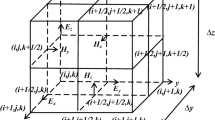Abstract
In this paper, a multi-static system working in an active way is made up of ionospheric oblique backscatter sounding system (IOBSS) and two separate receiving stations, which adopts discontinuous wave mechanism. We have advanced a new model that contains skywave condition to locate over-the-horizon targets. We use a single quasi-parabolic (QP) ionosphere model and an analytic ray-tracing program to obtain the coordinate registration (CR) index, which changes skywave group range to ground range. Also, IOBSS and other two receiving stations use this distance information to locate the target which is far away from the system. The analytic expression for the geometric dilution of precision (GDOP) under different station deployments are obtained, which shows GDOP is influenced by the system measurement precision, the stations’ coordinates, and CR index. By computer simulation, we find that GDOP of isosceles right triangle deployment is smaller than that of line deployment and location precision will be improved with increasing base line length. The results indicate that this model is practicable with an acceptable range of error (less than 500 m under certain conditions in this paper).
Similar content being viewed by others
References
Tang Xiaodong, Han Yunjie, Zhou Wenyu. Skywave Over-the-horizon backscatter radar[C]//Proceedings of 2001 CIE International Conference on Radar, Beijing: IEEE Press, 2001: 90–94.
Harlan J A, Georges T M, Biggs D C. Comparison of over-the-horizon radar surface-current measurements in the Gulf of Mexico with simultaneous sea truth[J]. Radio Science, 1998, 33(4): 1241–1247.
Root B T. HF-over-the-horizon radar ship detection with short dwells using clutter cancelation[J]. Radio Science, 1998, 33(4):1095–1111.
Sun Zhongkang, Zhou Yiyu, He Lixing. Active and Passive Location Techniques for Monostatic and Multistatic System [M]. Beijing: Defence Industry Press, 1996(Ch).
Chen Yongguang, Li Changjin, Li Xiuhe. A precision analyzing and reckoning model in tri-station TDOA location[J]. Acta Electronica Sinica, 2004, 32(9): 1452–1455(Ch).
Lu Jing, Guo Kecheng, Yuan Xiangyu, et al. Analytic method on location precision of three station differential-time-of-arrival location system[J]. Modern Radar, 2004, 26(12): 20–22(Ch).
Wheadon N S, Whitehouse J C, Milsom J D, et al. Ionospheric modelling and target coordinate registration for HF skywave radars[C]//Proc Sixth International Conference on HF Radio Systems and Techniques. York: IEEE Press, 1994: 258–266.
Zhou Chen. Research on Skywave Over-the-horizon Radar Coordinate Registration and Multipath Data Process[D]. Wuhan: School of Electronic Information, Wuhan University, 2009.
Dyson P L, Bennett J A. A model of the vertical distribution of the electron concentration in the ionosphere and its application to oblique propagation studies[J]. Journal of Atomspheric and Terrestrial Physics, 1988, 50(3): 251–262.
Norman R J, Dyson P L, Bennett J A. Quasicubic-segmented ionospheric model[J]. IEE Procceedings-Microwaves, Antennas and Propagation, 1996, 143(4): 323–327.
Chong Yanwen, Jiang Liu, Huang Tianci. The study on the three zoning treatment ray tracing method and its application [J]. J Wuhan Univ (Nat Sci Ed), 2003, 49(5): 663–666(Ch).
Chong Yanwen, Xie Shuguo, Zhao Zhengyu, et al. A new ray-tracing method—three zoning treatment[J]. Chinese Journal of Radio Science, 2001, 16(2): 222–226(Ch).
Zhou Xiangchun, Xie Shuguo, Zhao Zhengyu. The application of step-changing technique in ionospheric ray-tracing[J]. J Wuhan Univ (Nat Sci Ed), 2001, 47(3): 355–358(Ch).
Kelso J M. Ray tracing in the ionosphere[J]. Radio Science, 1968, 3(1): 1–11.
Dyson P L, Bennett J A. Exact ray path calculations using realistic ionospheres[J]. IEE Procceedings-Microwaves, Antennas and Propagation, 1992, 139(5): 407–413
Georges T M, Harlan J A, Lee T N, et al. Observations of the Florida Current with two over-the-horizon radars[J]. Radio Science, 1998, 33(4): 1227–1239.
Kurien T, Milanfar P, Logan D, et al. Propagation mode estimation: A prerequisite for OTH radar fusion[C]// Proceedings of 1994 IEEE International Conference on Multisensor Fusion and Integration for Intelligent Systems (MFI’94). Las Vegas: IEEE Press, 1994: 543–550.
Liu Yanhui, Nie Zaiping, Zhao Zhiqin. Cascaded approach for correcting ionospheric frequency modulation in HF sky-wave radars[J]. Journal of University of Electronic Science and Technology of China, 2009, 38(1): 17–21(Ch).
Author information
Authors and Affiliations
Corresponding author
Additional information
Foundation item: Supported by the National High Technology Research and Development Program of China (863 Program) (2009AAXXX1302)
Biography: SONG Jun, female, Ph. D. candidate, research direction: radio propagation, target location, and ionosphere application.
Rights and permissions
About this article
Cite this article
Song, J., Zhao, Z. & Zhou, C. A new location precision model for multi-static over-the-horizon radar system. Wuhan Univ. J. Nat. Sci. 15, 143–147 (2010). https://doi.org/10.1007/s11859-010-0211-z
Received:
Published:
Issue Date:
DOI: https://doi.org/10.1007/s11859-010-0211-z




